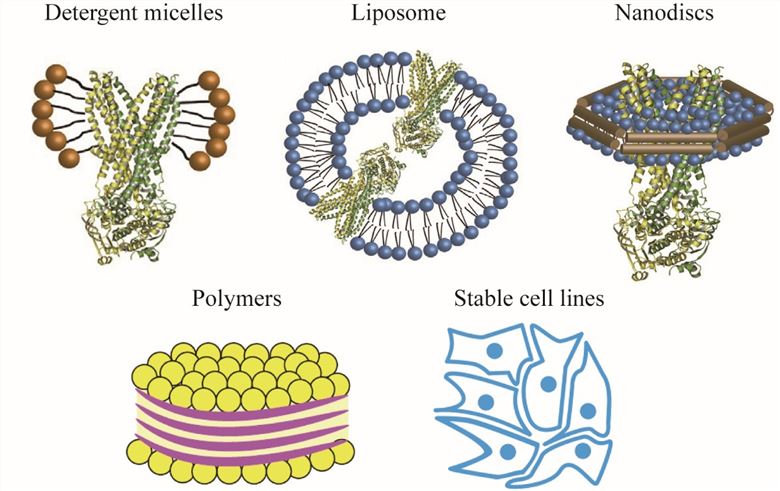Scientists from Creative Biolabs keep pursuing on state-of-the-art technologies to fulfill custom demands in various areas. After years of experience in membrane protein field, we have established an all-round Magic™ membrane protein platform. Now, we provide professional service of transporter immunogen preparation to accelerate anti-transporter antibody research and development for worldwide clients.
Integral proteins that function in the transport of ions, small molecules and macromolecules across biological membranes are called membrane transport proteins. Transporters, also known as carrier proteins, are one of the two basic types of membrane transport proteins. They act as channels for a large number of polar/non-polar water-soluble substances specifically by active or passive transport. Passive transport does not consume energy while active does. Na+/K+ ATPase and Ca2+ ATPase are examples of active transport transporters while Na+-driven glucose pump and Na+/Ca2+ exchanger are passive transport transporter examples. They have two conformations of either solute-binding or solute-absent state. (Fig 1)
 Fig 1 Transporter/carrier protein.
Fig 1 Transporter/carrier protein.
Transporters are involved in various important physiological activities, such as nutrients uptake, immune regulation, impulse conduction, etc. Therefore, they are attractive therapeutic targets in drug discovery field. Creative Biolabs now provides integral services of native, functional transporter preparation services for immunogen use. We provide flexible options, e.g. detergent micelles, nanodiscs, liposomes, polymers, over-expressing cells, lipoparticles, etc. (as listed below), which from you can always find a better fit for your particular target.
 Fig 2 Schematic of transporter as immunogen. (Claxton DP, et al. 2015)
Fig 2 Schematic of transporter as immunogen. (Claxton DP, et al. 2015)
This is a commonly used mild immunogen type in many cases. Transporters reconstituted in liposomes could maintain their correct fold and functional activities. With the aid of our Lipid Screening Platform, we could perform comprehensive condition screening to find the most proper lipid for each specific case. Proteoliposomes can be prepared from either cell-based expression or cell-free expression systems.
Nanodiscs makes another ideal immunogen option since they are more stable, homogenous and controllable in size. Most importantly, it offers a convenient reconstitution format not only highly mimics the natural plasma membrane, but also very flexible in terms of size and composition. makes it possible to avoid unwanted immune responses caused by the transmembrane region. As in this format the hydrophobic region is embedded into the phospholipid bilayer of nanodiscs, more homogeneous antibodies targeting excellular/intracellular domains can be raised. We offer integral nanodisc service from both cell-based expression and cell-free expression systems.
Polymers (amphipols or SMALPs) offers a new choice to produce transporters in detergent-free manner. Also, polymers show higher stable and soluble ability in aqueous solutions. Unlike detergent, it does not disrupt the native lipid environment enwrapping the target protein; instead, it can directly isolate and solubilize membrane-lipid complex. Hence, this detergent-free method could serve as immunogens with maximally preserved structure and activities.
We provide over 100 stably transfected cell lines (HEK293, CHO, etc) with high expression levels of GPCR, transporters, ion channels, etc. They can also be used directly for immunization & antibody selection. In contrast to recombinant proteins, transporters in cellular format have minimum risks in terms of native structure/functions/modification. Several key points for whole cell immunogen include sufficient expression levels, appropriate immunization process, and adequate antibody screening. Our professional team handles these key points well. This method is frequently used for immunization as well as antibody selection, which has proved remarkable success in many cases. Custom stable cell line can be constructed upon request.
Lipoparticles are formed by co-transfecting cells with viral core proteins (e.g. Gag) and membrane protein of interest. The viral core proteins can spontaneously capture plasma membrane fractions enriched with the target proteins when budding off from host cells. Transporter-displaying lipoparticles can be used for a wide variety of applications, such as animal immunization, antibody screening, drug delivery, assay development, etc.
Exosomes are secreted membrane nanovesicles (diameter 50-100 nm) that form within late endosomal compartments by the fusion of multivesicular bodies with the plasma membrane. Due to the formation mechanism, membrane orientation of exosomes is close to the orientation of the whole cell. Exosomes secreted from different cells share some similar properties of the whole cells. In addition, exosomes provide a native membrane environment with long, stable storage.
Creative Biolabs is more than happy to assist our clients to design and prepare the high-quality transporter immunogen of various formats. Please feel free to contact us for more details.
Reference
All listed services and products are For Research Use Only. Do Not use in any diagnostic or therapeutic applications.